Uranium Energy Corp.
NYSE American: UEC
Leading America’s Uranium Production Resurgence
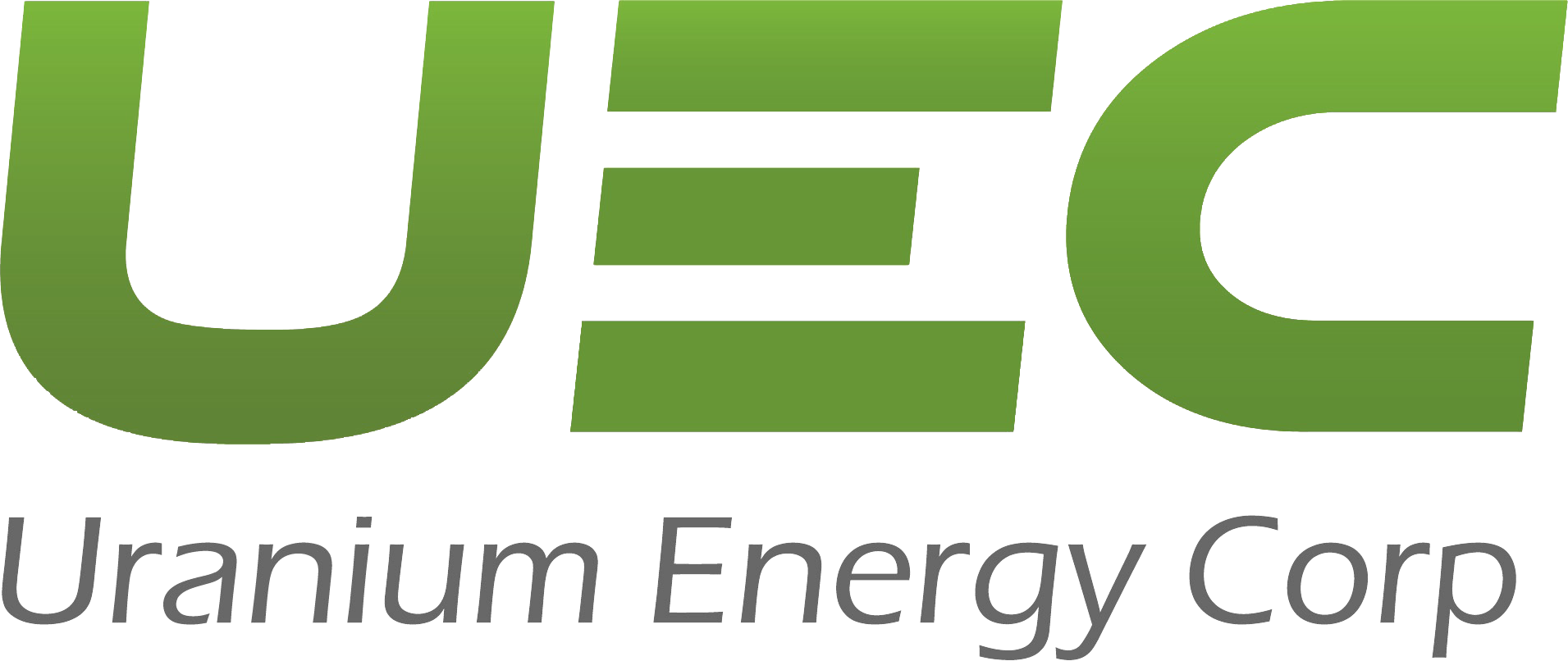
Texas-based Uranium Energy Corporation (NYSE American: UEC) is well-positioned to lead America’s resurgent uranium production sector as this critical clean-energy commodity braces for the national security stage amid major global supply disruptions.
In response, the US Nuclear Energy Industry just released a Department of Energy report entitled Restoring America’s Competitive Nuclear Energy Advantage.

The report outlines a series of measures aimed at revitalizing America’s uranium mining and nuclear power infrastructure including a $1.5 billion proposed budget to establish a National Uranium Reserve, similar to the Strategic Petroleum Reserve.
Uranium Energy Corporation (UEC) – currently trading just above $1 per share – is one of only a few publicly traded companies positioned to become a near-term US uranium producer and contributor to our pending National Uranium Reserve.
UEC has what I like to call the “3-P’s” for commencing near-term domestic U3O8 production: ISR Projects in the United States (with a 4 million pound per year production profile), fully Permitted, and led by a team of Professionals with a track record of getting the job done for shareholders.
In this Special Report… we’ll explore each of those critical components to success, and we’ll sit down for an in-depth, eye-opening interview with former US Energy Secretary and current Uranium Energy chairman — Spencer Abraham.
Uranium – commonly referred to as yellowcake or U3O8 – is the critical clean-energy metal responsible for nearly 20% of domestic electricity generation and for fueling America’s fleet of 84 nuclear powered aircraft carriers and submarines.
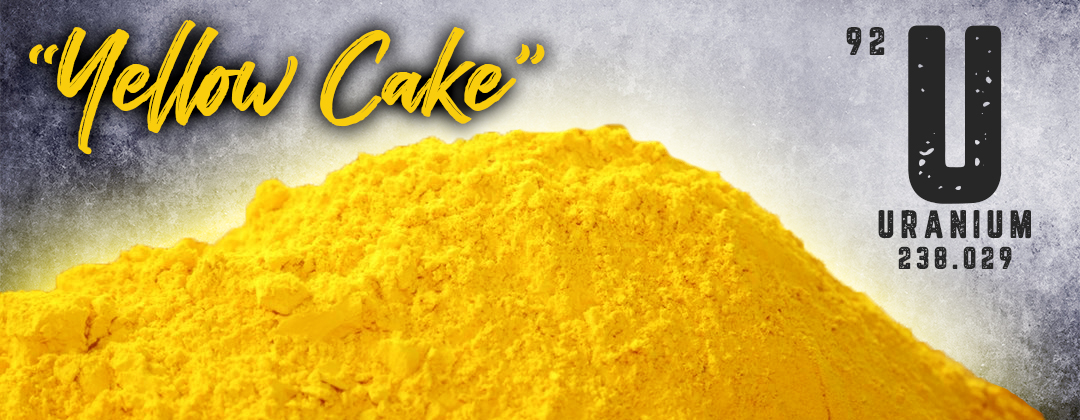
- Worldwide uranium production cuts and temporary mine closures in the face of the global coronavirus pandemic, and
- The release of a US Nuclear Fuel Working Group report addressing a multi-year domestic uranium production strategy designed to assure US national security.
The Nuclear Fuel Working Group’s newly-released recommendations to the US Administration outline a strategy for reestablishing critical domestic uranium production capabilities while providing direct support to the front-end of America’s nuclear fuel cycle, including:
| Purchasing 17 to 19 million lbs U3O8 from domestic producers starting this year | |||
| Establishing a National Uranium Reserve | |||
| Ending the DOE’s bartering of uranium | |||
| Reevaluating the DOE's excess uranium inventory management policy | |||
| Commencing direct purchases of $150 million in U3O8 per year for a period of 10 years; totaling $1.5 billion | |||
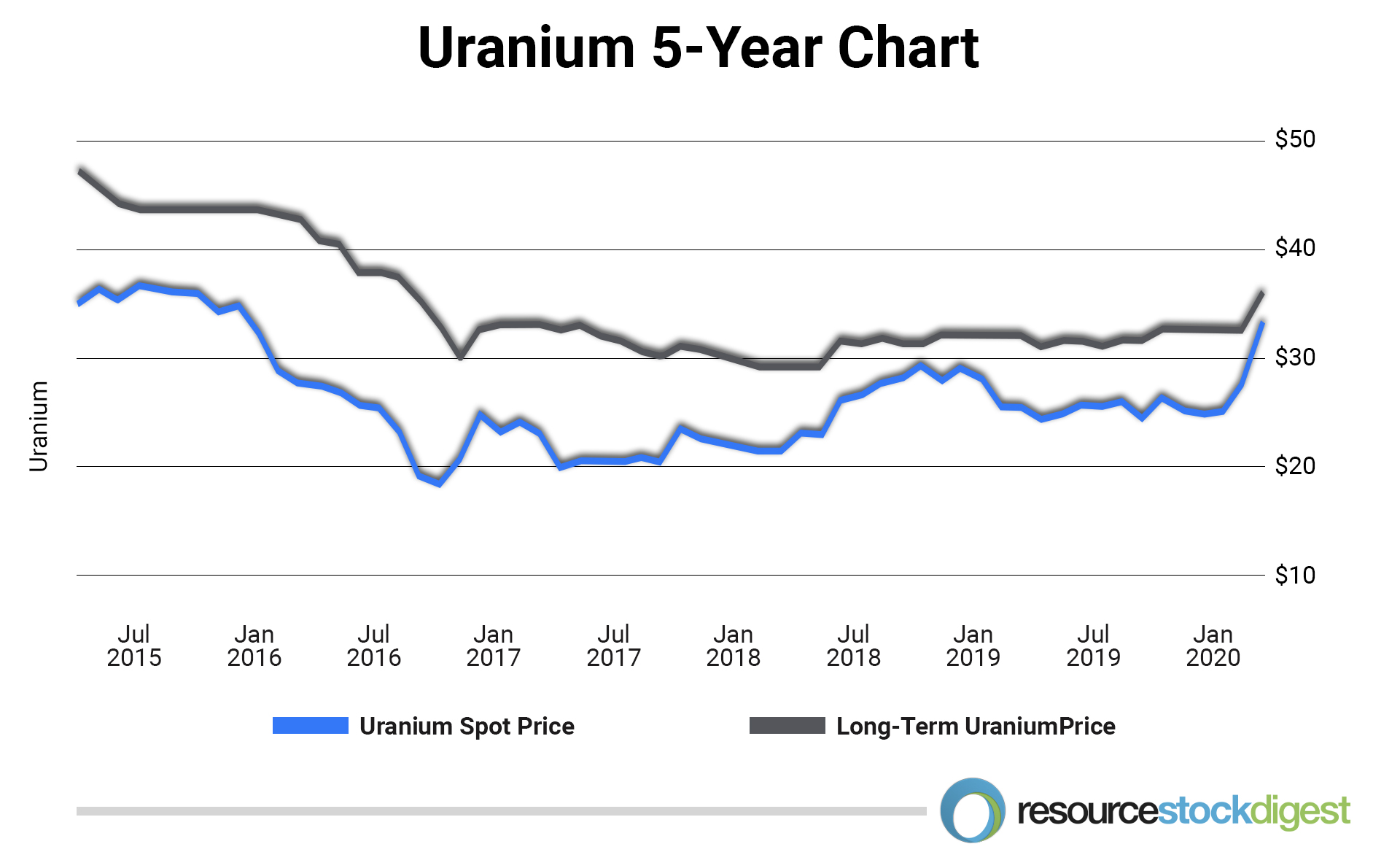
What we’re witnessing right now, as the world grapples with the COVID-19 pandemic, is a true Black Swan event of large-scale uranium mine shutdowns which are negatively impacting an astonishing 50% of global uranium production.
Already, in just the last couple of months, the uranium spot price has surged upward by some 37% from $24 per pound to over $33 per pound and appears poised to move higher still.
These global mine closures (some forced and others voluntary) are causing serious uranium supply disruptions as well as supply chain concerns. With such a fast-moving situation, it makes sense to look at things from a monthly perspective:
| Pre-COVID-19, global uranium production was anticipated to be around 11.85 million lbs per month. | |||
| We’re currently looking at global uranium production cuts of around 6.3 million pounds per month. | |||
| That means more than HALF of global monthly uranium production is being negatively impacted by the virus. | |||
As a result, U3O8 prices have already catapulted by a full third — marking the beginning of an upward trajectory that may last for years.
Uranium investors will recall the last time U3O8 prices went through the roof… rocketing all the way to $148/lb in 2007 following the catastrophic flooding of Cameco’s Cigar Lake Mine in 2006.
Currently, with the bevy of mine closures, including a temporary shutdown at the aforementioned Cigar Lake Uranium Mine in Canada’s Athabasca Basin, there are zero – I REPEAT — ZERO operating uranium mines in North America.
For the United States, that means 100% of our uranium needs are coming from overseas suppliers — mostly from Kazakhstan. And now, Kazakhstan – the world’s leading uranium producer – is having significant COVID-19 related disruptions of its own.
So what we’re looking at, really, is an unprecedented supply chain disruption for a critical clean energy metal that’s required for 20% of America’s electricity needs — not to mention the fuel required for our fleet of nuclear powered aircraft carriers and submarines. The national security concerns are obvious.

And that’s why – based on recommendations from the US Nuclear Fuel Working Group – expectations are for the formation of a National Uranium Reserve this year with uranium purchases commencing in 2021.
Keep in mind that the United States – as the world’s largest user of uranium – consumes over 40 million pounds of yellowcake every year and has no domestic production.
Thus, it makes sense that US utilities – which make up about 20% of global uranium demand – are going to want to build domestic uranium supply into their portfolios, of which there is currently none.
Uranium Energy Corporation, well before the COVID-19 crisis, foresaw this escalating need for domestically produced uranium for America’s national security and took aggressive measures to position itself as a future low-cost producer in a rising U3O8 market.
Most importantly, the company has spent considerable time and energy getting permits in-place for its low-cost ISR uranium projects, which means it’s poised to move swiftly toward production as U3O8 prices continue to trend higher — ideally north of $50 per pound in short order.
TRANSLATION: Uranium Energy Corp. – currently trading just north of $1 per share – is one of only a handful of publicly-traded US uranium exploration and development companies with the capability of attaining near-term domestic U3O8 production.
A Proven Acquisition & Development Strategy
The Uranium Energy team, led by president and CEO, Amir Adnani, utilized the most recent downturn in the global uranium sector to systematically acquire one of the largest databases of historic uranium exploration and development in the entire country.
That database is now enabling the company to advance its impressive suite of fully permitted, low-cost ISR uranium projects primarily located in the US states of Texas, Wyoming, New Mexico and Colorado — a hot-bed for American uranium resources.
In Wyoming, UEC controls the Reno Creek ISR Uranium Project, which is the largest permitted, pre-construction ISR (in-situ recovery) uranium project in the nation.
Remember, permits can oftentimes take 5 to 10 years to acquire. That puts Uranium Energy Corporation in the unique position of being able to expeditiously ramp up to uranium production as the price for yellowcake continues to rise amid unprecedented global supply disruptions.
It’s equally important to note that ISR projects are considered a much lower-cost and much more environmentally-friendly alternative to conventional uranium mining and represent the preferred uranium mining methodology in the US along with the largest source of growth in uranium production globally.
One of the company’s most advanced properties is the Reno Creek ISR Uranium Project, Wyoming, which boasts a measured and indicated resource of 32 million tons grading 0.041% U3O8 containing 26 million pounds of uranium and an inferred resource of 1.92 million tons grading 0.039% U3O8 containing 1.49 million pounds.
The project is licensed to produce 2 million pounds of U3O8 per year and received a modified Permit to Construct in 2019, allowing the company to move forward with construction of ISR wellfields that could also contribute to the US Uranium Reserve Program.

In South Texas, UEC’s hub-and-spoke operations are anchored by the fully built and licensed Hobson Processing Facility (see below) which is central to the company’s Palangana, Burke Hollow, and Goliad ISR uranium projects.

The facility has a capacity of 2 million pounds U3O8 per year and has license amendments pending to increase that capacity.
UEC’s Palangana ISR Uranium Mine is a past producer, has proven production capabilities, and received renewal permits in 2019 authorizing extraction for an additional 10 years.
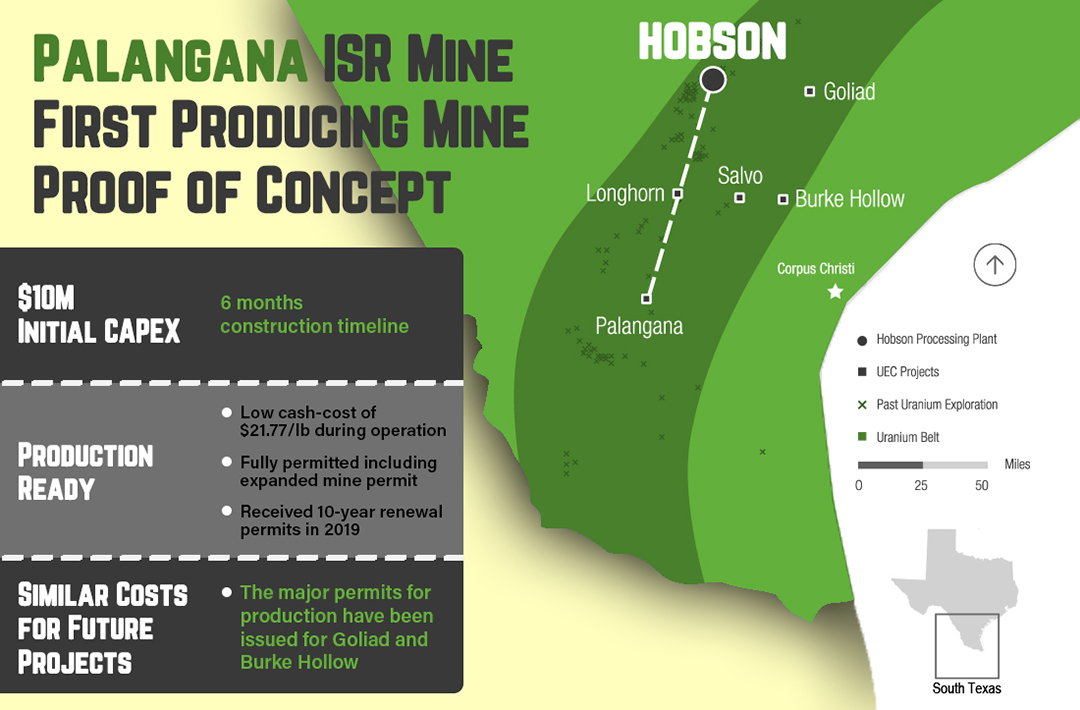
The project has a measured and indicated resource estimate of 393,000 tons grading 0.135% U3O8 containing 1,057,000 pounds and an inferred resource of 328,000 tons grading 0.176% U3O8 containing 1,154,000 pounds U3O8.
Combined, UEC has a near-term extraction profile of 4 million pounds U3O8 per year from its Wyoming and South Texas ISR projects — putting the company in the driver’s seat for near-term, low-cost domestic uranium production.
An Impressive Team of Industry Professionals
 |
UEC is led by Amir Adnani, president & CEO, who is also the founder of GoldMining, Inc., a gold-resources acquisition and development company that has grown to control a sizable portfolio of gold projects across the Americas. |
|
 |
Spencer Abraham, whom you’ll be hearing from in just a moment, is a former US Energy Secretary and currently serves as UEC’s chairman. Under his stewardship the department made major advances in the development of new energy technologies, successfully implemented a variety of nuclear non-proliferation and nuclear security programs after the September 11 attacks, and launched initiatives aimed at improving the nation’s energy security. |
|
 |
Scott Melbye, executive vice president, boasts 35 years of experience in senior roles with uranium majors Cameco, Uranium One, and Kazatomprom. Scott is the former president of Uranium Producers of America and chair of the World Nuclear Fuel Market. |
|
 |
 |
 |
Rounding out the team are Robert Underdown (VP of Production), Clyde Yancey (VP of Exploration), and Andy Kurrus (VP of Resource Development) who together bring more than 100 years of combined industry experience to the company.
Interview with Uranium Energy
Chairman, Spencer Abraham

I had the honor of gaining access to former US Energy Secretary and current Uranium Energy chairman, Spencer Abraham.
This comes in the wake of the Nuclear Fuel Working Group’s report to President Trump that recommends, among many other things, direct purchases from US producers to create a National Uranium Reserve.
Currently, the United States produces zero uranium. So today, right now, is the ground floor.
This is all extremely timely considering that the coronavirus pandemic has taken some 50% of global uranium production offline. As oil prices have collapsed, uranium prices are surging.
Please enjoy the interview.
Mike Fagan: Mr. Abraham, we’ve witnessed a historic event for the US Nuclear Energy Industry with the recent release of a Department of Energy report and recommendation to revitalize our uranium mining and nuclear power infrastructure in the US, including a $1.5 billion proposed budget to establish a National Uranium Reserve, similar to the strategic petroleum reserve.
As a former US Energy Secretary, how far do you think the actions outlined in the recent DOE report go toward achieving the President’s vision of a vibrant and self-sustaining US nuclear energy industry for both defense and commercial needs?
Spencer Abraham: Mike, the decisions and the proposed $1.5 billion National Uranium Reserve are indeed historic and go a long way toward addressing America’s vulnerability to foreign imports of critical parts of the nuclear fuel cycle. Once they are translated into action, we will definitely see the US uranium production sector revitalized.
The Nuclear Fuel Working Group report outlines a sound, strategic framework that will reestablish the infrastructure America needs to support our long-term nuclear defense needs, critical for our national security. The commercial sector should also benefit from actions put into place, that will in time, reduce America’s overdependence on foreign imports from Russia and other former Soviet Union (FSU) countries that distort free market pricing.
America’s current lack of a viable nuclear fuel supply chain exposes a vulnerability to other countries’ actions that are not always aligned with US interests. This is an unacceptable position for our long-term security. The predatory market threats from State-Owned-Enterprises (SOEs) must be stopped or the US risks serious exposure to trade actions that can cause serious disruptions to American prosperity and our way of life.
MF: How long would it take, starting from zero, for the US to become essentially self-sufficient in uranium production like it has done with oil?
SA: The Uranium Producers of America polled its members as to the incentive cost of production, capital requirements, human resources, and the status of permitted and licensed projects that can be developed or restarted.
The poll revealed, with sufficient incentive pricing, the domestic uranium industry could ramp back up to 20 million pounds of annual U3O8 production within 10 years. While this does not reach the 47 million pounds of average annual US commercial reactor requirements, there are no technical limits to produce higher quantities.
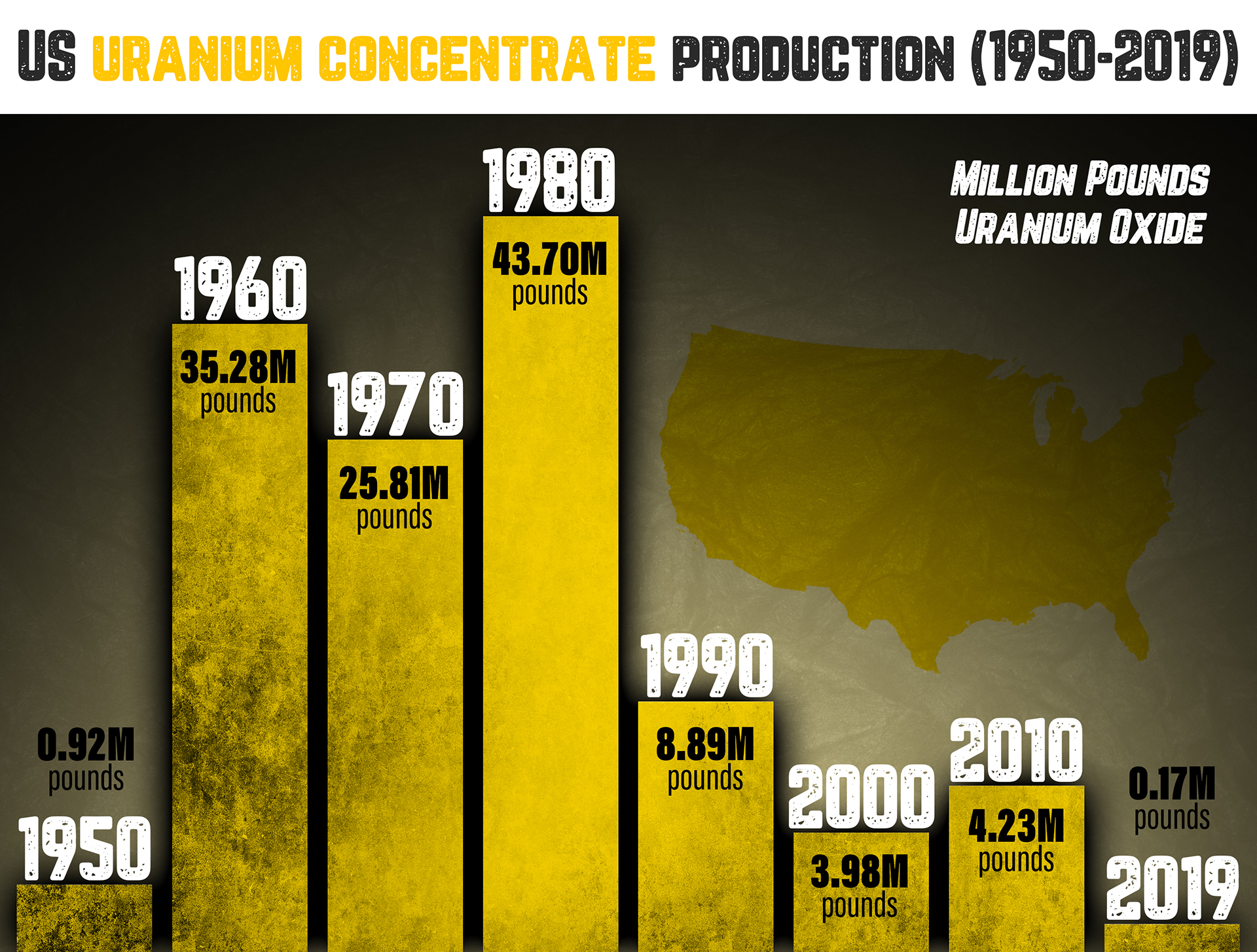
The United States Geological Survey estimates that over 2 billion pounds of uranium resources are either known, or likely to be discovered, in the United States.
It should be recognized that not all US mines are equal with respect to production costs, and some, like UEC’s fully permitted in-situ recovery (ISR) mines, will have a distinct advantage over higher cost conventional mines.
MF: Mr. Abraham, the report makes frequent mention of Small Modular Reactors. How do they fit, in your view, into America’s clean energy future?
SA: Mike, Small Modular Reactors (SMRs) are going to play an important role in America’s future for the highly reliable, carbon-free energy that nuclear power provides. The safe and effective deployment of SMRs in our fleet of aircraft carriers and submarines since the 1950’s has proven the US leadership and proficiency in this technology.

We have seen recent bipartisan legislation pass the US Congress providing support for these innovative and advanced reactors. SMRs are typically small 50-100 MWe reactors that can be built in a factory, shipped, and installed on-site in a scalable fashion. In addition to the clean energy and carbon-free benefits, shorter construction times, lower upfront capital, and faster return on investment will make them an attractive option for energy planners.
The US military is also committed to the deployment of micro-reactors at foreign military bases to avoid dependence on unreliable local grids and reduce the amount of vulnerable fuel-oil convoys in active conflict zones. UEC believes the use of this technology will continue to grow and will be a robust component of expanding uranium demand.
MF: How important is it for this technology and the fuel to be American-made in the context of our current reliance on foreign nations for fuel and the sensitivities around security for the entire nuclear supply chain?
SA: As you know, the COVID-19 crisis has highlighted the importance of supply chain security with respect to essential components. US national security is threatened with overreliance on foreign supply sources for many critical materials necessary for our economy and our defense systems.
Uranium is an essential critical mineral and is needed to maintain our electricity grid since 20% of our power supply comes from America’s 95 operating reactors.
We have an additional 108 reactors in our fleet of 84 aircraft carriers and submarines that must, by international treaty, run on 100% domestic uranium fuel. Our overdependence on FSU countries’ nuclear fuel supply has hampered US policy objectives.
In this regard, our nuclear fuel supply from Russia hamstrings the Administration’s ability to impose sanctions on Russia for their support of Iran’s nuclear enrichment program that could easily be weaponized against the US or our allies. Also, underscoring the risk to our supply chain, more than 50% of global uranium production is currently shut down due to the coronavirus pandemic, and there is no production currently in North America.
We simply cannot remain dependent on FSU countries and others to be our source of supply for something as critical as our nuclear fuel supplies.
MF: Mr. Abraham, as the chairman of Uranium Energy Corp., what does this mean for the future of uranium mining in America?
SA: If the President’s plan is implemented, it means a positive and successful future for companies like UEC. America has the people and the resources to make a significant contribution to the nuclear energy industry, and UEC is well-positioned to be a major contributor in a resurgence of domestic production.
UEC presently has four fully permitted ISR uranium projects in the United States with a 4 million pound per year production profile that can play a central role in the President’s American uranium revitalization plan.
UEC has existing infrastructure and proven production at Palangana and Hobson in South Texas that is ready for restart and scalable for growth with our hub-and-spoke strategy. Our newest mine, Burke Hollow, began development last year and when completed will be a satellite operation to our Hobson processing plant.
And in Wyoming, we have been consolidating and advancing our fully permitted Reno Creek project which represents the largest, permitted, pre-development ISR mine in the United States.
MF: As a former Senator and Secretary of Energy, what does that mean for America?
SA: Mike, it means one less thing to worry about for our national security leaders. However, the program needs to be implemented now to preserve an industry that has been decimated with SOEs predatory market behavior.
The US nuclear fuel supply chain is competitive in free market economies but cannot compete with SOEs that are supported by foreign governments. The sooner we implement the strategy, the sooner we can put the mining industry back to work and the sooner we can end the overreliance on SOE supply from countries that are not always aligned with our interests.
The Trump Administration’s Nuclear Fuel Working Group report is titled Restoring America’s Competitive Nuclear Energy Advantage and highlights another focus of this ground-breaking nuclear energy policy — restoring American nuclear export competitiveness.

It was not that long ago that US uranium mines led global production, and US companies like GE and Westinghouse were selling and constructing nuclear power plants all around the world. Today, this leadership position is occupied by Russia and China.
What is important at this stage is for the Administration and Congress to come together, in a bipartisan fashion, to implement the policy recommendations of this energy and national security plan. As this occurs, UEC stands ready to restart and expand our low-cost, environmentally-friendly production from our US ISR projects.
The Opportunity
For all of the reasons outlined in this Special Report, a revitalization of America’s uranium industry appears imminent. We’re already seeing the beginning stages of this pending resurgence with the recent U3O8 price move from $24/lb to above $33/lb.
The Nuclear Fuel Working Group has made its recommendations to the US administration which includes $1.5 billion in domestic uranium purchases over 10 years and the establishment of a National Uranium Reserve.
You just heard from former US Energy Secretary and current UEC chairman, Spencer Abraham. He says:
“If the President’s plan is implemented, it means a positive and successful future for companies like UEC. America has the people and the resources to make a significant contribution to the nuclear energy industry, and UEC is well-positioned to be a major contributor in a resurgence of domestic production.”
The bottom line is that there are very few US uranium exploration and development firms that are set to go with fully permitted projects once the signal flashes green.
That makes Uranium Energy Corp. (UEC) – with its 4 fully permitted ISR uranium projects, 4 million pound per year production profile, and fully licensed processing facility – a go-to name in the space.
It also puts UEC in the rare position of being able to quickly ramp up to domestic production once US utilities begin making U3O8 purchases in the open market.
Keep in mind also that, over the last three years, Uranium Energy has been able to complete acquisitions and financings to grow its business at an average price of around $1.50 per share. UEC is currently trading just above $1 per share.
TRANSLATION: A ground floor opportunity is now being presented to foresighted investors seeking exposure to a resurgent US uranium market.
Based on its fully permitted asset base in the United States, I’m excited to see what this company can achieve over the next 12 to 18 months. Right now is an opportune time for investors to commence their own due diligence on Uranium Energy Corporation — symbol UEC on the American Stock Exchange.
Yours In Profits,
Mike Fagan, Editor
Resource Stock Digest
Learn more about Uranium Energy Corporation by clicking here.
And click here to get real-time updates from the company on their Twitter feed.